by Paul Gilster | Mar 13, 2024 | Outer Solar System |
We’re a species that likes to leave evidence of itself in new places. In Greenland, for example, the Kingittorsuaq runestone, dating from the 14th Century, offers inscriptions that help chart Norse exploration of the region. The oldest inscription at New Mexico’s El Morro dates from 1605, though many explorers left their names and stories on the cliffs there. Apollo 11’s plaque, with its “We came in peace for all mankind” is justly famous, as are the Golden Records of the two Voyagers and the Pioneer plaques, even if the latter were dogged with controversy at the time of their unveiling.

Image: The Kingittorsuaq runestone. Credit: Ukendt /Nationalmuseet, Danmark, CC BY-SA 2.5 DK , via Wikimedia Commons.
Clearly the Solar System is wide open for future plaques and markers, so that NASA’s inclusion of a plaque aboard Europa Clipper comes as no surprise. The poem it carries focuses, of course, on that intriguing moon, and I rather like poet Ada Limón’s “In Praise of Mystery: A Poem for Europa” except for its first stanza. I snag on the word ‘expansiveness,’ and the notion of a sky inky with it. The word ‘expanse’ is itself so liminal, especially as applied to an inky night sky, that it carries its own freight of awe.
To this jaded ear, ‘expansiveness’ is bloated. I can’t imagine saying ‘the sky is certainly inky with expansiveness tonight.’ So I’ll pass on stanza 1, but go for the rest of the poem, which is a deft evocation of water’s place in our evolution and our explorations:
Arching under the night sky inky
with black expansiveness, we point
to the planets we know, we
pin quick wishes on stars. From earth,
we read the sky as if it is an unerring book
of the universe, expert and evident.
Still, there are mysteries below our sky:
the whale song, the songbird singing
its call in the bough of a wind-shaken tree.
We are creatures of constant awe,
curious at beauty, at leaf and blossom,
at grief and pleasure, sun and shadow.
And it is not darkness that unites us,
not the cold distance of space, but
the offering of water, each drop of rain,
each rivulet, each pulse, each vein.
O second moon, we, too, are made
of water, of vast and beckoning seas.
We, too, are made of wonders, of great
and ordinary loves, of small invisible worlds,
of a need to call out through the dark.
Those last three stanzas form a fine conclusion; the poem ends with a satisfying click describing its mission, which is to fly aboard Europa Clipper and wind up hurtling past the target world again and again, battered by radiation as it hunts for information about an alien sea. What a good thing it is to put human artifacts on spacecraft. There is scant likelihood, of course, that the Europa poem, flying along with a microchip containing 2.6 million names submitted by the public, will one day be read by anyone, but the impulse is to commemorate and inspire ourselves. It’s something we humans do.
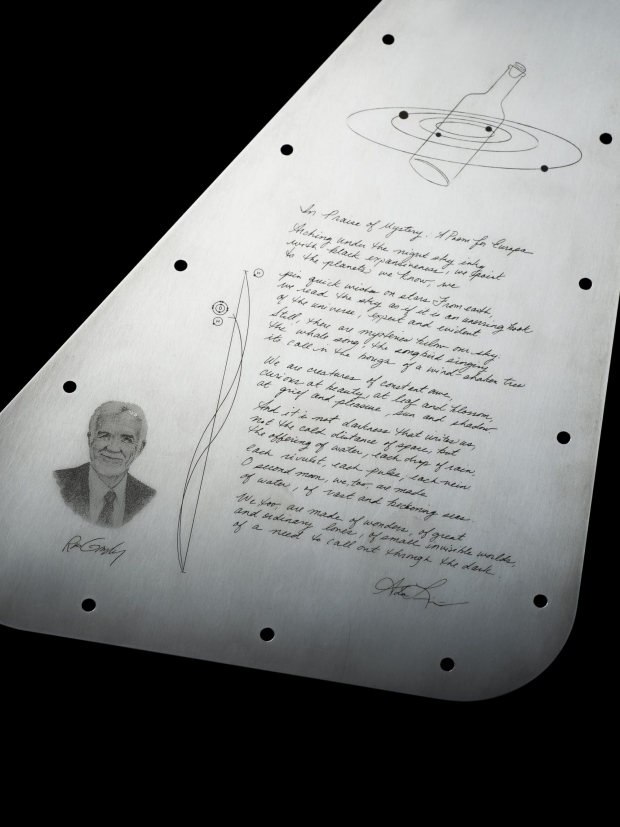
Image: The lower half of Europa Clipper’s vault plate, showing the poem by U.S. poet laureate Ada Limón (lower right), a drawing representing the Jovian system that will host the names of 2.6 million people flying with the mission on a microchip (top right), a tribute to planetary scientist Ron Greely (bottom left), and the radio emission lines known as the ‘Water Hole’ (center). Credit: NASA/JPL-Caltech.
As a collector and user of vintage fountain pens, I am particularly pleased to see that the poem is inscribed in the author’s handwriting, a nice touch in an era increasingly learning that writing by hand, though rarely taught these days, is actually a powerful way to explore and retain ideas. The vault plate, which you can explore here, likewise contains Frank Drake’s handwriting. Drake (1930-2022), among much else in a magnificent career, contributed the first SETI search, at Green Bank in West Virginia, and the seminal Drake Equation, which estimates the probability of finding life elsewhere in the cosmos and describes the factors critical to the discussion.

Image: The upper half of Europa Clipper’s vault plate, showing the Drake Equation in Frank Drake’s own handwriting. Credit: NASA/JPL-Caltech
The Europa Clipper vault plate is small, measuring 1 millimeter in thickness and 18 X 28 centimeters. What I’ve described so far is the inner-facing plate. The outer side contains a visual representation of the word for ‘water’ spoken in 103 languages, with the central symbol the sign for water in American Sign Language. Water, after all, is why we are probing Europa. Audio renditions of these words are contained as visual waveforms representing each sound. They look a bit runic to me.
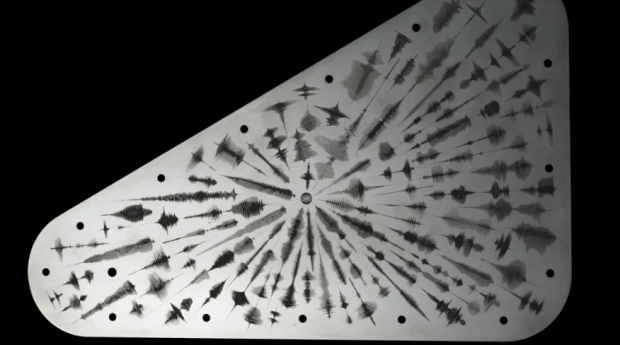
Image: The art on this side of the plate, which will seal an opening of the vault on NASA’s Europa Clipper, features waveforms that are visual representations of the sound waves formed by the word “water” in 103 languages. At center is a symbol representing the American Sign Language sign for “water.” Credit: NASA/JPL-Caltech.
We’re going to get 49 close passes of Europa if all goes well when the spacecraft arrives in 2030. The commemorative plate seals an opening in the metal vault which will protect the craft’s sensitive electronics from the sleet of particles produced by interactions between the planet and its magnetic fields. We can hope to learn a good deal more about the thickness of the moon’s icy crust, its interactions with the ocean below, the composition of that ocean, and the geology of the surface. We’re getting close to Europa Clipper’s launch, slated for October at Kennedy Space Center.
Jupiter’s radiation belts, we’ve recently learned, may play a role in what goes on in the ocean below. As a paper in Nature Astronomy explains, the bombardment of ionized particles can split any water molecules encountered on the surface, producing oxygen that could find its way into the ocean. Thus lead author Jamey Szalay (Princeton University):
“Europa is like an ice ball slowly losing its water in a flowing stream. Except, in this case, the stream is a fluid of ionized particles swept around Jupiter by its extraordinary magnetic field. When these ionized particles impact Europa, they break up the water-ice molecule by molecule on the surface to produce hydrogen and oxygen. In a way, the entire ice shell is being continuously eroded by waves of charged particles washing up upon it.”
The Juno spacecraft’s Jovian Auroral Distributions Experiment (JADE) instrument flew within 354 kilometers of the surface in September of 2022, measuring the hydrogen and oxygen ions created by the particle bombardment. The work allowed a calculation of the rate of oxygen being produced at Europa, which turns out to be about 12 kilograms per second (previous estimates have reached as high as 1000 kilograms per second). “[W]hat we didn’t realize,” adds Szalay, “is that Juno’s observations would give us such a tight constraint on the amount of oxygen produced in Europa’s icy surface.” How much of this oxygen, if any, works its way into the ocean to provide potential metabolic energy is something Europa Clipper should help us understand.
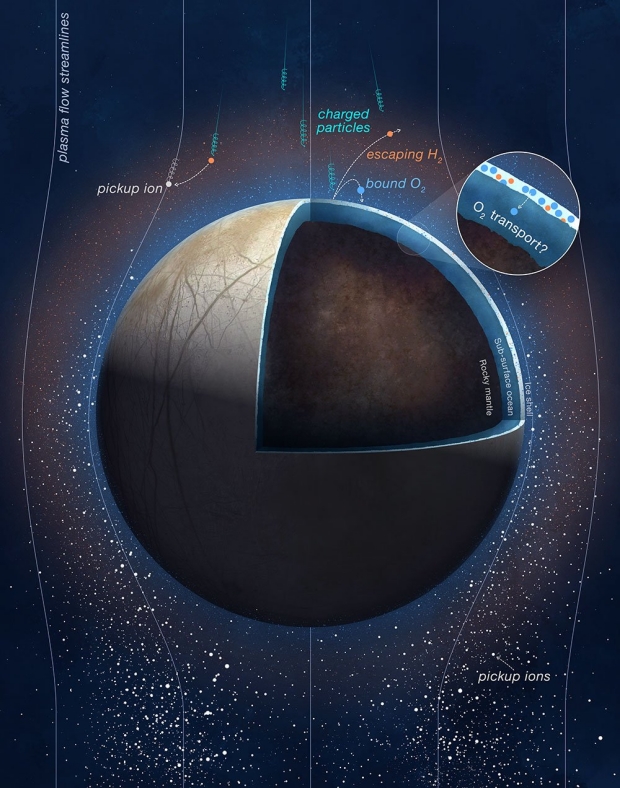
Image: This illustration shows charged particles from Jupiter impacting Europa’s surface, splitting frozen water molecules into oxygen and hydrogen molecules. Scientists believe some of these newly created oxygen gases could migrate toward the moon’s subsurface ocean, as depicted in the inset image. Credit: NASA/JPL-Caltech/SWRI/PU.
The paper is Szalay et al., “Oxygen production from dissociation of Europa’s water-ice surface,” Nature Astronomy 04 March 2024 (full text).

by Paul Gilster | Aug 31, 2023 | Outer Solar System |
The idea that we might take an active, working spacecraft in the Kuiper Belt and not only repurpose it for a different task (heliophysics) but also dismiss the team that is now running it is patently absurd. Yet this appears to be a possibility when it comes to New Horizons, the remarkable explorer of Pluto/Charon, Arrokoth, and the myriad objects of the Kuiper Belt. NASA’s Science Mission Directorate, responding to a 2022 Senior Review panel which had praised New Horizons, is behind the controversy, about which you can read more in NASA’s New Horizons Mission Still Threatened.
So absurd is the notion that I’m going to assume this radical step, apparently aimed at ending the Kuiper Belt mission New Horizons was designed for on September 30 of 2024, will not happen, heartened by a recent letter of protest from some figures central to the space community, as listed in the above article from Universe Today. These are, among a total of 25 planetary scientists, past Planetary Society board chair Jim Bell, Lori Garver (past Deputy Administrator of NASA), Jim Green (Past Director of NASA’s Planetary Science Division), Candice Hansen-Koharcheck (Past chair of the American Astronomical Society’s Division of Planetary Sciences and Past Chair of NASA’s Outer Planets Assessment Group), author Homer Hickham, Wesley T. Huntress (Past Director of NASA’s solar system Exploration Group), astrophysicist Sir Brian May, and Melissa McGrath (past NASA official and AAS Chair of DPS).
Needless to say, we’ll keep a wary eye on the matter (and I’ve just signed the petition to save the original mission), but let’s talk this morning about what New Horizons is doing right now, as the science remains deeply productive. I like the way science team member Tod Lauer spoke of the spacecraft’s current position in a recent post on the team’s website, a place where “It’s still convenient to think of neat north and south hemispheres to organize our vista of the sky, but the equator is now defined by the band of the galaxy, not our spinning Earth, lost to us in the glare of the fading Sun.”
Places like that evoke the poet in all of us. Lauer points out that the New Horizons main telescope is no more powerful than what amateur stargazers willing to open their checkbooks might use in their backyards. Part of the beauty of the situation, though, is that New Horizons moves in a very dark place indeed. While I have vivid memories of seeing a glorious Milky Way bisecting the sky aboard a small boat one summer night on Lake George in the Adirondacks, how much more striking is the vantage out here in the Kuiper Belt where the nearest city lights are billions of kilometers away?

Image: A Kuiper Belt explorer looks into the galaxy. Credit: Serge Brunier/Marc Postman/Dan Durda
The science remains robust out here as well. Consider what Lauer notes in his article. Looking for Kuiper Belt objects using older images, the New Horizons team found that in all cases, even objects far from the Milky Way’s band appeared against a background brighter than scientists can explain, even factoring in the billions of galaxies that fill the visible cosmos. The puzzle isn’t readily solved. Says Lauer:
…we then tried observations of a test field carefully selected to be far away from the Milky Way, any bright stars, clouds of dust – or anything, anything that we could think of that would wash out the fragile darkness of the universe. The total background was much lower than that in our repurposed images of Kuiper Belt objects – but by exactly the amount we expected, given our care at pointing the spacecraft at just about the darkest part of the sky we could find. The mysterious glow is still there, and more undeniable, given the care we took to exclude anything that would compete with the darkness of the universe, itself. You’re in an empty house, far out in the country, on a clear moonless night. You turn off all the lights everywhere, but it’s still not completely dark. The billions of galaxies beyond our Milky Way are still there, but what we measure is twice as bright as all the light they’ve put out over all time since the Big Bang. There is something unknown shining light into our camera. If it’s the universe, then it’s just as strong, just as bright, as all the galaxies that ever were.
Only New Horizons can do this kind of work. How far are we from Earth? Take a look at the animated image below, which is about as vivid a reminder as I can find.

Image: Two images of Proxima Centauri, one taken by NASA’s New Horizons probe and the other by ground-based telescopes. The images show how the spacecraft’s view, from a distance of 7 billion kilometers, is very different from what we see on Earth, illustrating the parallax effect. Credit: NASA/Johns Hopkins Applied Physics Laboratory/Southwest Research Institute/Las Cumbres Observatory/Siding Spring Observatory.
With 15 more dark fields slated for examination this summer, New Horizons remains active on this and many other fronts. In his latest PI’s Perspective, Alan Stern notes the eight-week period of observations taking place now and through September. include continued observations of KBOs, imaging of the ice giants, dust impact measurements, mapping of hydrogen gas in the outer heliosphere, analysis using the ultraviolet spectrometer to look for structures in the interstellar medium, and spatial variations in the visible wavelength background. Six months of data return will be needed to download the full set for the planetary, heliospheric and astrophysics communities.
According to Stern, new fault protection software will allow New Horizons to operate out to 100 AU. That assumes we’ll still be taking Kuiper Belt data. Given the utterly unique nature of this kind of dataset and the fact that this spacecraft is engaged in doing exactly what it was designed to do, it is beyond comprehension that its current mission might be threatened with a shakeup to the core team or a reframing of its investigations. I’ve come across the National Space Society’s petition to save the New Horizons Kuiper Belt mission late, but please take this chance to sign it.

by Paul Gilster | Aug 29, 2023 | Outer Solar System |
Trans-Neptunian Objects, or TNOs, sound simple enough, the term being descriptive of objects moving beyond the orbit of Neptune, which means objects with a semimajor axis greater than 30 AU. It makes sense that such objects would be out there as remnants of planet formation, but they’re highly useful today in telling us about what the outer system consists of. Part of the reason for that is that TNOs come in a variety of types, and the motions of these objects can point to things we have yet to discover.
Thus the cottage industry in finding a ninth planet in the Solar System, with all the intrigue that provides. The current ‘Planet 9 Model’ points to a super-Earth five to ten times as massive as our planet located beyond 400 AU. It’s a topic we’ve discussed often in these pages. I can recall the feeling I had long ago when I first learned that little Pluto really didn’t explain everything we were discovering about the system beyond Neptune. It simply wasn’t big enough. That pointed to something else, but what? New planets are exciting stuff, especially when they are nearby, as the possibility of flybys and landings in a foreseeable future is real.
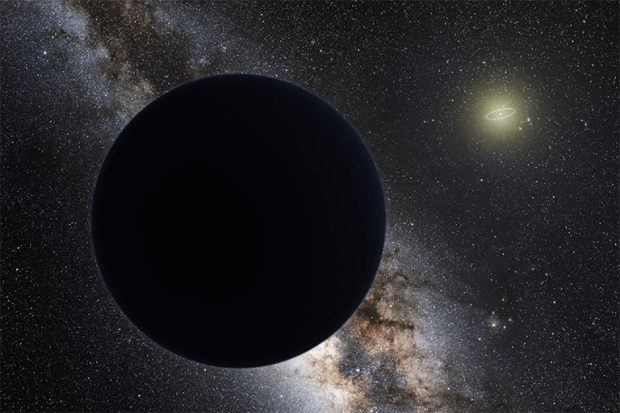
Image: An artist’s illustration of a possible ninth planet in our solar system, hovering at the edge of our solar system. Neptune’s orbit is show as a bright ring around the Sun. Credit: ESO/Tom Ruen/nagualdesign.
But a different solution for a trans-Neptunian planet is possible, as found in the paper under discussion today. Among the active researchers into the more than 1000 known TNOs and their movements are Patryk Sofia Lykawka (Kobe University) and Takashi Ito (National Astronomical Observatory of Japan), who lay out the basics about these objects in a new paper that has just appeared in The Astronomical Journal. The astronomers point out that we can use them to learn about the formation and evolution of the giant planets, including possible migrations and the makeup of the protoplanetary disk that spawned them. But it’s noteworthy that no single evolutionary model exists that would explain all known TNO orbits in a unified way.
So the paper goes to work on such a model, and while concentrating on the Kuiper Belt and objects with semimajor axes between 50 and 1500 AU, the authors pin down four populations, and thus four constraints that any successful model of the population must explain. The first of these are detached TNOs, meaning objects that are outside the gravitational influence of Neptune and thus not locked into any mean motion resonance with it. The second is a population the authors consider statistically significant, TNOs with orbital inclinations to the ecliptic above 45 degrees. This population is not predicted by existing models of early Neptune migration.
The paper is generous with details about these and the following two populations, but here I’ll just give the basics. The third group consists of TNOs considered to be on extreme orbits. Here we fall back on the useful Sedna and other objects with large values for perihelion of 60 AU or more. These demand that we find a cause for perturbations beyond the four giant planets, possibly even a rogue planet’s passing. Any model of the outer system must be able to explain the orbits of these extreme objects, an open question because interactions with a migrating Neptune do not suffice.
Finally, we have a population of TNOs that are stable in various mean motion resonances with Neptune over billions of years – the authors call these “stable resonance TNOs” – and it’s interesting to note that most of them are locked in a resonance of approximately 4 billion years, which points to their early origin. The point is that we have to be able to explain all four of these populations as we evolve a theory on what kind of objects could produce the observable result.
What a wild place the outer Solar System would have been during the period of planet formation. The authors believe it likely that several thousand dwarf planets with mass in the range of Pluto and “several tens” of sub-Earth and Earth-class planets would have formed in this era, most of them lost through gravitational scattering or collisions. We’ve been looking at trans-Neptunian planet explanations for today’s Kuiper Belt intensely for several decades, but of the various suggested possibilities, none explained the orbital structure of the Kuiper Belt to the satisfaction of Lykawka and Ito. The existing Planet 9 model here gives way to a somewhat closer, somewhat smaller world deduced from computer simulations examining the dynamical evolution of TNOs.
What the authors introduce, then, is the possibility of a super-Earth perhaps as little as 1.5 times Earth’s mass with a semimajor axis in the range of 250 to 500 AU. The closest perihelion works out to 195 au in these calculations, with an orbit that is inclined 30 degrees to the ecliptic. If we plug such a world into this paper’s simulations, we find that it explains TNOs that are decoupled from Neptune and also many of the high-inclination TNOs, while being compatible with resonant orbit TNOs stable for billions of years. The model thus broadly fits observed TNO populations.
But there is a useful addition. In the passage below, the italics are mine:
…the results of the KBP scenario support the existence of a yet-undiscovered planet in the far outer solar system. Furthermore, this scenario also predicts the existence of new TNO populations located beyond 150 au generated by the KBP’s perturbations that can serve as observationally testable signatures of the existence of this planet. More detailed knowledge of the orbital structure in the distant Kuiper Belt can reveal or rule out the existence of any hypothetical planet in the outer solar system. The existence of a KBP may also offer new constraints on planet formation and dynamical evolution in the trans-Jovian region.
A testable signature is the gold standard for a credible hypothesis, which is not to say that we will necessarily find it. But if we do locate such a world, or a planet corresponding to the more conventional Planet 9 scenarios, we will have ramped up our incentive to explore beyond the Kuiper Belt, an incentive already given further impetus by our growing knowledge of the heliosphere and its interactions with the interstellar medium. But to the general public, interstellar dust is theoretical. An actual planet – a place that can be photographed and one day landed upon – awakens curiosity and the innate human drive to explore with a target that pushes all our current limits.
The paper is Lykawka & Ito, “Is There an Earth-like Planet in the Distant Kuiper Belt?,” Astronomical Journal Vol. 166, No. 3 (25 August 2023) 118 (full text).

by Paul Gilster | Aug 25, 2023 | Outer Solar System |
We’re living in a prime era for studying the Solar System’s movement through the galaxy, with all that implies about stellar evolution, planet formation and the heliosphere’s interactions with the interstellar medium. We don’t often think about movements at this macro-scale, but bear in mind that the Sun and the planets are now moving through the outer edges of what is known as the local interstellar cloud (LIC), having been within the cloud by some estimates for about 60,000 years.

What happens next? I always think about Poul Anderson’s wonderful Brain Wave when contemplating such matters. In the classic 1954 tale, serialized the year before in Space Science Fiction during the great 1950s boom in science fiction magazines, Brain Wave depicts the Earth’s movement out of an energy-damping field it had moved through since the Cretaceous. When the planet moves out of this field at long last, everyone on the planet gets smarter. What will happen when we leave the LIC?
Nothing this dramatic, as far as anyone can tell, but we’re moving into the so-called G-cloud, a somewhat denser region we’ll get to know within a few thousand years (Alpha Centauri is already within the G-cloud). The LIC appears to be about 30 light years across, sporting somewhat higher density hydrogen than the interstellar medium around it and flowing from the direction of Scorpius and Centaurus. We seem to be moving through its outer edge.
Image: That’s a Richard Powers cover on the first edition of Poul Anderson’s Brain Wave, illustrating a novel Anderson considered one of his best.
The word ‘denser’ has to be kept in perspective. Consider that about half of the interstellar gas – hydrogen and helium for the most part – takes up 98 percent of the space between the stars and is thus extraordinarily low in density, The other half of this gas is compressed into 2% of the volume and is found in molecular clouds, mostly molecular hydrogen, that include some carbon monoxide and higher concentrations of dust than the surrounding ISM.
We’d like to know more about the G-cloud, and in particular such factors as its temperatures and density, for just how the heliosphere reacts to this changing environment, presumably through compression, could have effects upon its shape and thus its shielding effects from cosmic rays. Thus the importance of the Interstellar Probe mission (ISP) out of Johns Hopkins Applied Physics Laboratory that we’ve discussed often in these pages (I’ll point you to Mapping Out Interstellar Clouds for more on the subject). One thing I noted in an article last year was that there are alternative models to the Sun’s nearby cloud environment, some challenging the idea that the LIC and the G-cloud are distinct regions. Interstellar Probe would help in the investigation.
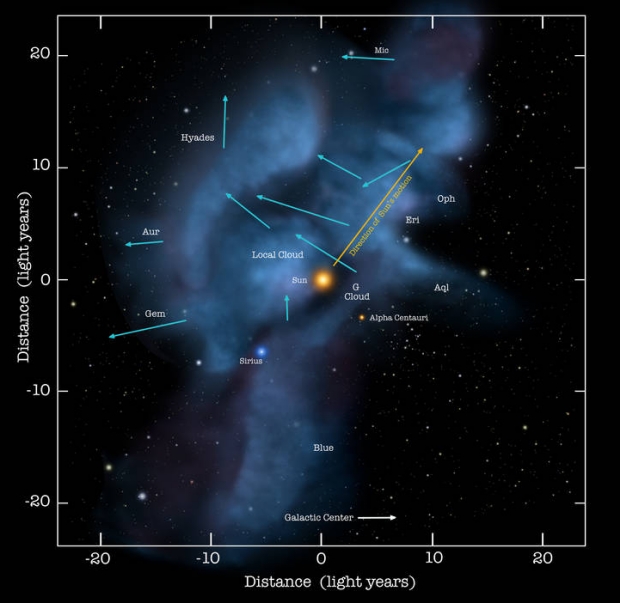
Image: Our solar journey through space is carrying us through a cluster of very-low-density interstellar clouds. Right now the Sun is inside of a cloud (Local cloud) that is so tenuous that the interstellar gas detected by the IBEX (Interstellar Boundary Explorer mission) is as sparse as a handful of air stretched over a column that is hundreds of light-years long. These clouds are identified by their motions, indicated in this graphic with blue arrows. Credit: NASA/Goddard/Adler/U. Chicago/Wesleyan.
The fate of Interstellar Probe is the hands of the National Academies of Sciences, Engineering, and Medicine, which prioritizes in its decadal studies where we are going in space exploration over ten year periods. We find out next year whether ISP has been selected among several strong candidates for the Decadal Survey for Solar and Space Physics (Heliophysics) 2024-2033. Until then, I continue to scout the literature both for Interstellar Probe as well as JPL’s Solar Gravitational Lens (SGL) mission, a candidate for the same study. These are huge decisions in space science.
Be aware of a new paper tackling the issues of heliospheric and dust science that a mission like Interstellar Probe could examine, with a solid backgrounder on the kind of instrumentation that would make this first dedicated interstellar probe a game-changer in our understanding of the local interstellar environment. The paper, by lead author Veerle J. Sterken (ETH Zürich) and colleagues, was originally submitted to the heliophysics Decadal, and is here available in a modified version (citation below) that includes the new instrumentation discussion among other modifications.
I won’t run through the entire paper; suffice it to say that its discussion of interstellar dust in and around the heliosphere is comprehensive and its analysis of how best to study changing environments in the interstellar medium is highly informative. The benefit of a probe explicitly designed to examine the transition between dust and gas states along its trajectory are clear. From the paper, which notes here the particular importance of heliopause passage:
ISP will fly throughout approximately 16 years, more than a solar cycle, while passing through interplanetary space, the termination shock, the heliosheath, up to the heliopause and beyond, making it an optimal mission for studying the heliosphere-dust coupling and using this knowledge for other astrospheres. Beyond the heliopause, the tiny dust with gyro-radii of only a few to 100 AU (for dust radii < 0.1 μm…), will help study the interstellar environment (magnetic field, plasma) and may detect local enhancements of smaller as well as bigger ISD [interstellar dust]. The strength of the mission lies in flying through all of these diverse regions with simultaneous magnetic field, dust, plasma and pickup ion measurements. No mission so far has flown a dedicated dust dynamics and composition suite into the heliosheath and the vast space beyond.
Analyzing the interaction between the heliosphere and interstellar dust acts as a probe into the history of our own Solar System, since we know that some of this material was affected by near-Earth supernovae, still raining down in the form of dust today. Mid-sized dust particles in the range of 0.1 to 0.6 μm in radius can make it through the heliosphere into the Solar System. Some smaller particles (30-100 nm) as well may escape filtering, but the authors note the limitations of our knowledge: “The exact lower cut-off size and time-dependence of particles that can enter the solar system is not yet exactly known, but Ulysses and Cassini already have measured ISD particles with radii between 50 and 100 nm.”
Thus we have markers for stellar and galactic evolution as factors in this study. But I’ll also remind those interested in interstellar flight that assessing dust density and the size distribution of particles will play a major role when we reach the point where we can send craft at a significant fraction of the speed of light. Larger particles in the local interstellar environment could cause catastrophic failure, while Ian Crawford has pointed out that other properties of this region could inform propulsion concepts like the interstellar ramjet.
Something else I learned from Ian Crawford (University of London) and wrote about twelve years ago (see Into the Interstellar Void) is that a spacecraft moving at 0.1c could make daily measurements 17 AU apart, which is roughly half the radius of the Solar System. So as we develop the fastest probe we can manage today in the form of designs like Interstellar Probe, we can see a larger picture in which such studies assist as we develop future technologies capable of actually making a crossing to Alpha Centauri, sampling widely along the way two different interstellar clouds and the boundary between them.
The paper is Sterken et al., “Synergies between interstellar dust and heliospheric science with an Interstellar Probe,” submitted as white paper for the National Academies Decadal Survey for Solar and Space Physics 2024-2033 and available as a preprint here.

by Paul Gilster | Aug 21, 2023 | Outer Solar System |
As a book-dazzled kid growing up in St. Louis, I had the good fortune to be surrounded by books from previous generations, and specifically those belonging both to my father and my half-brother, who had died long before I was born. Among these was a multi-volume encyclopedia from the 1920s I’ve never been able to identify. All I have is the memory of looking through its musty volumes and realizing that Pluto was not listed in it, as the publication date was a few years earlier than Clyde Tombaugh’s epic search for the world.

I do remember thinking that without Pluto, the Solar System only had eight planets, and musing in my teenage boy way about how odd this incomplete view of the Solar System was. Little did I know how much more was in store! As to that eighth planet, Neptune was a puzzler not only to the encyclopedia but to science fiction writers of the Gernsback era. Thus James Morgan Walsh’s “The Vanguard to Neptune,” published in Wonder Stories Quarterly in the Spring, 1932 issue. In the cover by Frank R. Paul, that’s Neptune hanging in the sky, looking for all the world like a terrestrial planet, here seen from Triton. The explorers assume the blue areas are ice until they cross to the planet.
Image: Frank R. Paul’s cover illustration for J. M. Walsh’s “The Vanguard to Neptune.” Walsh (1897-1952) was an interesting figure in his own right for those of us who spent a career living off the printed word. Settling in the UK, the Australian novelist would pen an astounding 94 novels across a wide range of genres and under a variety of pseudonyms. It was possible to do that kind of thing in the pulp era.
Spurring these recollections are images of Neptune revealed in a new study on the planet’s cloud cover and its relation to the solar cycle. They’re so stunning that I wanted to reproduce them here, thinking about how our knowledge of the Solar System has advanced since my first acquaintance with the planet in that encyclopedia as no more than a speck of light amongst countless others. There’s also a bit of the Voyager 2 thrill as the craft approached Neptune back in 1989 deep in the summer night here. To see new worlds open before us. Astonishing.
I suppose one day we’ll get so completely accustomed to imaging exoplanets that such thrills will seem commonplace, or maybe not, given their sheer diversity. But the images below still work for me, the first set from Hubble.
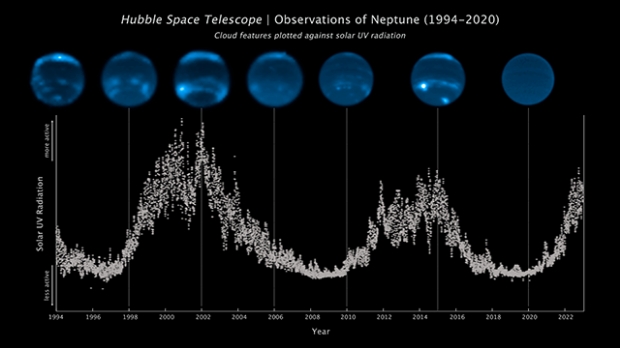
Image: This sequence of Hubble Space Telescope images chronicles the waxing and waning of the amount of cloud cover on Neptune. This nearly-30-year-long set of observations shows that the number of clouds grows increasingly following a peak in the solar cycle – where the Sun’s level of activity rhythmically rises and falls over an 11-year period. The Sun’s level of ultraviolet radiation is plotted in the vertical axis. The 11-year cycle is plotted along the bottom from 1994 to 2022. The Hubble observations along the top, clearly show a correlation between cloud abundance and solar peak of activity. The chemical changes are caused by photochemistry, which happens high in Neptune’s upper atmosphere and takes time to form clouds. Credit: NASA, ESA, LASP, Erandi Chavez (UC Berkeley), Imke de Pater (UC Berkeley).
I don’t mean to neglect the import of the paper that features these observations, which comes from astronomers at UC-Berkeley, or their conclusions, which use the numerous changes in the patterning of Neptune’s clouds to point to the connection with the flip in the Sun’s magnetic field every eleven years. It’s intriguing to learn that when the Sun emits more intense ultraviolet light, and in particular the strong hydrogen Lyman-alpha emission, there is increasing cloud cover on Neptune fully two years later.
Imke de Pater (UC-Berkeley) is senior author on the study:
“These remarkable data give us the strongest evidence yet that Neptune’s cloud cover correlates with the Sun’s cycle. Our findings support the theory that the Sun’s UV rays, when strong enough, may be triggering a photochemical reaction that produces Neptune’s clouds.”
We see 2.5 cycles of cloud activity on Neptune recorded over a 29-year period in observations not only from Hubble but Keck Observatory and Lick Observatory, in which it also becomes clear that there is a relationship between the number of clouds and the planet’s observed brightness. Below is the Keck imagery.
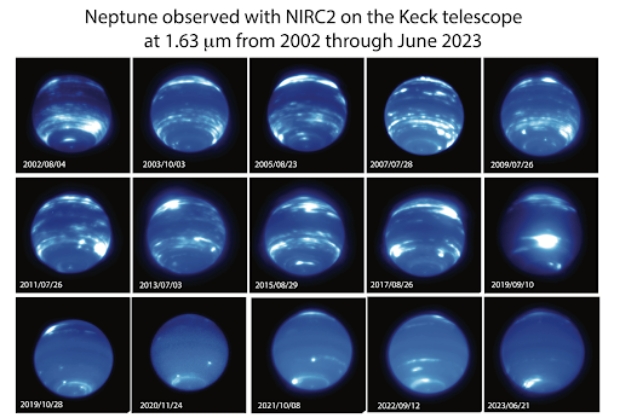
Image: A dramatic change in Neptune’s appearance was observed in late 2019 and has persisted through June 2023. As shown by this compilation of images at 1.63 µm (microns) obtained with the NIRC2 and adaptive optics system on the Keck II Telescope, Neptune had numerous cloud features organized in latitudinal bands from before 2002 through late 2019. Afterwards, clouds appeared almost absent except near the south pole. The images are displayed using a Asinh function which, like a log-scale display, decreases the contrast between the features; if displayed on a linear scale, only the brightest features would be visible. Credit: Imke de Pater, Erandi Chavez, Erin Redwing (UC Berkeley)/W. M. Keck Observatory.
This is tricky analysis, because as the paper points out, clouds not related to photochemical reactions, as for example those produced by storms rising up from the deep atmosphere, would complicate correlations with the solar cycle. More recent imagery from the summer of this year has begun to show more clouds in the northern latitudes and at high altitude, which de Pater says reflects the observed increase in the solar ultraviolet flux in the past two years. It’s chastening to realize that even with 30 years of high resolution data covering almost three solar cycles, we have still covered only 20 percent of Neptune’s orbit. Oh for an ice-giant orbiter to depict up close the chaotic actions on a planet whose winds are the strongest known in the Solar System.
The paper is Chavez et al., “Evolution of Neptune at near-infrared wavelengths from 1994 through 2022,” Icarus Vol. 404 (1 November 2023), 115667 (abstract).

by Paul Gilster | May 9, 2023 | Outer Solar System |
Further fueling my interest in reaching the ice giants is a study in the Journal of Geophysical Research: Planets that investigates the possibility of oceans on the major moons of Uranus. Imaged by Voyager 2, Uranus is otherwise unvisited by our spacecraft, but Miranda, Ariel, Titania, Oberon and Umbriel hold considerable interest given what we are learning about oceans beneath the surface of icy moons. Hence the need to examine the Voyager 2 data in light of updated computer modeling.
Julie Castillo-Rogez (JPL) is lead author of the paper:
“When it comes to small bodies – dwarf planets and moons – planetary scientists previously have found evidence of oceans in several unlikely places, including the dwarf planets Ceres and Pluto, and Saturn’s moon Mimas. So there are mechanisms at play that we don’t fully understand. This paper investigates what those could be and how they are relevant to the many bodies in the solar system that could be rich in water but have limited internal heat.”

Image: This is Figure 1 from the paper. Caption: Densities and mean radii of the Uranian moons compared to those of other large moons and dwarf planets. Miranda has a low density similar to Saturn’s moon Mimas, whereas the densities of the other Uranian moons are more similar to Saturn’s moons Dione and Rhea. After Hussmann et al. (2006).
The interest is more than theoretical, for as we’ve recently discussed the Planetary Science and Astrobiology Decadal Survey for 2023–2032 has put a Uranus Orbiter and Probe mission on its short list of priorities. A mission to Uranus would open up the prospect for confirming oceans, or the lack of same, within the five large moons. Recent work explored in the Castillo-Rogez paper has made the case that magnetic fields induced by such oceans should be detectable by a Uranus orbiter’s flybys.
Much has happened to call for new modeling of this system. The paper notes recent advances in surface chemistry and geology, revised models of system dynamics, and the knowledge gained on icy bodies in the size range of the Uranian moons as studies have continued on Enceladus and the moons of Saturn as well as Pluto and Charon, not to mention the availability of data from the Dawn mission at Ceres. The team’s modeling produces likely interior structures that are promising for four of the moons.
These moons are indeed small objects, and while Uranus has 27 moons, it is only when we reach the size of Ariel (1160 kilometers) that we can start talking realistically about interior oceans. Titania is the largest of these at 1580 kilometers. The paper argues that of the five largest moons, we can exclude Miranda (470 kilometers) as being too small to sustain the heat to support an internal ocean. But the other four appear promising, revising and contradicting earlier work that had focused primarily on Titania and Oberon in the belief that Ariel, Umbriel, and Miranda would be frozen at present.
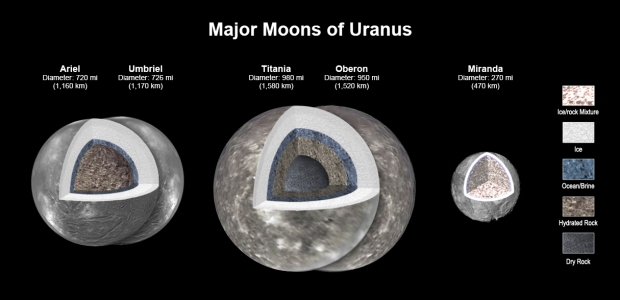
Image: New modeling shows that there likely is an ocean layer in four of Uranus’ major moons: Ariel, Umbriel, Titania, and Oberon. Salty – or briny – oceans lie under the ice and atop layers of water-rich rock and dry rock. Miranda is too small to retain enough heat for an ocean layer. Credit: NASA/JPL-Caltech.
Of the large Uranian moons, Ariel may emerge as the best possibility. From the paper:
Ariel is particularly interesting as a future mission target because of the potential detection of NH3-bearing species on its surface (Cartwright et al., 2021) that could be evidence of recent cryovolcanic activity, considering these species should degrade on a geologically short timescale. Geologic features, visible in Voyager 2 Imaging Science Subsystem images of Ariel, show some evidence for cryovolcanism in the form of double ridges and lobate features that may represent emplaced cryolava (Beddingfield & Cartwright, 2021).
But oceans tens of kilometers deep at Titania and Oberon may yet excite astrobiological interest, depending on what we learn about heat sources here.
Based on current understanding, we conclude that the Uranian moons are more likely to host residual or “relict” oceans than thick oceans. As such, they may be representative of many icy bodies, including Ceres, Callisto, Pluto, and Charon (De Sanctis et al., 2020). The detection and characterization (depth and thickness) of deep oceans inside the Uranian moons… and refined constraint on surface ages would help assess whether these bodies still hold residual heat from a recent resonance crossing event and/or are undergoing tidal heating due to dynamical circumstances that are currently unknown (as was the case at Enceladus before the Cassini mission).
The Uranus Orbiter and Probe mission holds great allure for answering some of these questions. The issue of detection by a spacecraft is still charged, however. The authors note from the outset that an ocean maintained primarily by ammonia would be well below the water freezing point, in which case its electrical conductivity might be too low to register on the UOP’s sensors. In other words, ammonia essentially acts as an antifreeze, with electrical conductivity near zero. Temperatures below ~245 K would mean an ocean would have to be detected by the exposure of deep ocean material, in which case we come back to Ariel as the most likely target for the closest scrutiny.
The paper is Castillo-Rogez et al., “Compositions and Interior Structures of the Large Moons of Uranus and Implications for Future Spacecraft Observations,” JGR Planets Vol. 128, Issue 1 (January 2023). Abstract.




















